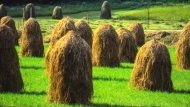In the summer, they grazed their livestock on the mountains wherever it was possible to have pastures. In many places, they cleared forests for this purpose and also set up simple shelters for the shepherds and cheesemakers.
In the valley, the meadows were mostly mown twice, in June for hay and then towards the end of summer for aftermath.
In the lower alpine pastures and meadows, they could first graze the livestock for a while in the spring, and then in July, the meadows were mown for fodder. Meanwhile, the livestock grazed in the higher alpine pastures.
The hay was stored in haylofts (svisli), and in the winter, they would go and retrieve it, while in some places, they brought it down to the valley immediately. In Bohinj, for example, they transported the hay down to the valley in winter using sledges.
Mowing used to be a special occasion for the family. Other mowers always helped as well. They set off to the meadows early in the morning, as the grass is much easier to mow when it’s still dewy. They would line up diagonally on the meadow and mow simultaneously.
The scythe had to be sharpened in advance, and they always carried an "osovnek" around their waist—a container with water and a whetstone, which they used to sharpen the scythe as needed.
Meanwhile, the women and girls carefully prepared a snack and brought it to them.
The grass dried throughout the day, sometimes even the next day. It had to be turned over with rakes or wooden forks. Once dried, it was raked into windrows, and then either stored in the hayloft or taken to the valley with a "lojtrnik" (a traditional wagon with ladders on the sides).
In many places, the hay was stacked in hayracks for two weeks. Since summer thunderstorms are common, it would be difficult for the hay to dry without a roof. In the Primorska region, hay was dried on "ostrgače" (wooden branches).
Among the most endangered plants are meadow wildflowers. In many parts of Europe, for example, meadow clary is already a true rarity. In Slovenia, efforts are being made to preserve biodiversity in meadows, at least in protected areas.
Thank you.

































